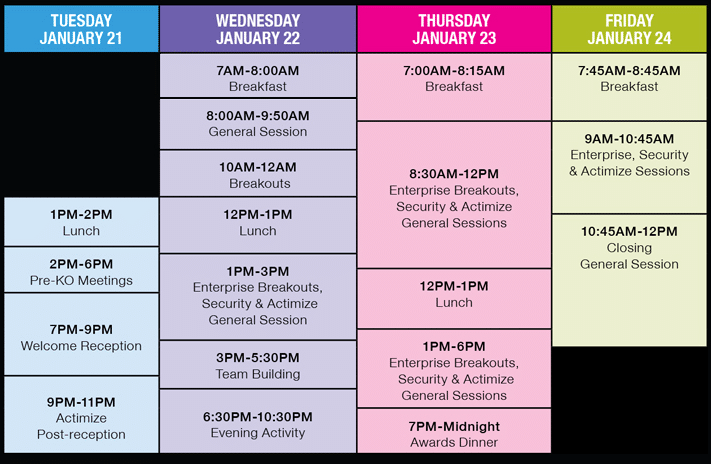Whether you’re directly involved in sales or not, you know that a sales kickoff (SKO) can motivate sales teams and help beat quotas. You also know that an unsuccessful SKO is a waste of time, money, and brain power, and can detract from your company’s momentum.
Add Crunchbase data to your CRM with Crunchbase Enterprise
As you prepare for your Q2 SKO, or the next time you find yourself in SKO planning crunch time, work your way through the following seven steps and you’ll be sure to drive sales success year-round.
1. Invest in your environment
Crowded rooms and and coffee-less presentations are sure to thwart the energy of your salespeople. Think about the energy you want to inspire through presentations and match that with the space you use or rent for your SKO. A few things to consider:
- Lighting
- Acoustics
- Stage visibility
- Layout and accessibility
- Capacity
- Temperature (especially if your SKO is in January)
Cultivating a great environment also includes investing in refreshments and food for your employees, both when they arrive and throughout the day. Though the sticker shock of providing for your sales organization can be alarming, think about this as a two-way street; your sales team will be inspired to invest in your company throughout the year if you invest in them now.
This doesn’t mean every meal needs to be catered by a Michelin star chef. It does mean there should be snacks and beverages available throughout the day to keep people hydrated, fed, and focused.
Don’t skimp on location, food, or refreshments.
2. Develop and distribute a clear agenda
There is plenty of work to be done before your salespeople set foot in the event space you’ve selected. Developing and distributing an engaging and a well-thought out agenda should be high on your priority list. Remember, your audience is comprised of salespeople, so tailoring your agenda to social personalities is a must.
Presentations and specific sessions should be kept to 60 minutes and quickly be followed by a break, or short breakout sessions. Develop breakout sessions according to specific sales training needs to keep people engaged. There is nothing more yawn-inducing than a day filled with font size eight on consecutive PowerPoint slides.


Photo Source: Action Nice Sales Kickoff
If possible, share your agenda in advance of the SKO. Though last minute changes are sure to happen, giving people a roadmap of what to expect throughout the event can help them plan ahead and stay engaged.
Clear agendas are a must-have to keep your SKO audience engaged.
3. Secure compelling speakers
Diversifying your speakers will limit your CEO’s time on the soap box and ensure visibility into multiple facets of your business. If possible, bring in non-employees (i.e. customers, investors) and include these speakers on your agenda to drive audience interest.
Set aside time for a Q&A session with key speakers or company executives near the end of the day. Your salespeople may have unanswered questions, and the more visibility they have into the minds of those in leadership, the more likely they are to trust their vision.
Diversify your speakers and allot time for questions through Q&A sessions.
4. Outline your objectives, goals and expectations
It’s imperative to open your SKO with an objective to set the stage for why this conference is important – whether you’re on the cusp of a new funding round or revamping after a difficult year. Once you’ve grounded your audience in your objective, it’s time to get your employees excited about the quarter/year ahead. Outline your company’s short- and long-term goals, clearly connecting how these goals will help achieve your company’s mission.
As always, transparency is key. Explain any differences in growth trajectory from previous quarters, detailing how and why these goals were set, and leave room for questions during and after the presentation.
Define your objective and align on clear business goals.
5. Lead with data
Numbers matter. Your sales teams are driven by their individual quotas, but it is important to track how these quotas ladder up to the bottom line. Begin the SKO with opening statements from your CEO, or another executive, and have them do a deep dive into the sales team’s performance over the last year. Be sure your presenter addresses shortcomings, missteps or adjustments made along the way.
Don’t think data can be sexy? Think again. The way in which your company’s data is presented can either intrigue or quickly lose the interest of your audience. Data visualization can help breathe life into bland numbers and trends data – whether that be graphs, charts, or tables that clearly articulate trends and results.
Most importantly, leave room for questions. This is not a time for your CEO to wax poetic about confusing numbers, this is a time for an open and honest report and discussion about the trajectory of your business. Ensure you leave at least 10 minutes for questions from the audience, and encourage employees to ask questions as they arise.
Highlight key learnings and trends and keep your salespeople engaged with data visualization.
6. End on a positive note
Your SKO may have been filled with exciting news, text-light PowerPoints, and breakout sessions, but ending the conference on a high note will leave your sales team feeling motivated and ready to take on the year.
Have your CEO, or another compelling speaker, deliver the day’s closing statements and incorporate time for recognition of employees in a meaningful way.
Outside of President’s Club, there are many other strategies to acknowledge employees going above and beyond – even a quick shout out from your CEO can make all the difference in an employee’s feelings toward the company, and inspire others to strive for similar recognition.
Beyond shout outs, closing remarks should reiterate the ambitious goals you set throughout the conference and restate objectives and target growth.
Follow the day with a community-building activity. Whether you simply name a restaurant nearby that all are welcome to go to after the day closes, or you have the means to sponsor a happy hour, ensure your sales team has the opportunity to come together and connect with each other before heading home for the day.
Employee recognition goes a long way, and don’t forget to schedule a post-SKO activity!
7. Follow-up and follow through
Building excitement and energy is useless if you can’t sustain it. Generate and sustain momentum by ensuring your teams have access to resources and content shared throughout your SKO.
Leverage your internal communications team to encapsulate key takeaways in a SKO readout and resource email in the days following the event. But, most importantly, don’t let a follow-up email be the end of your post-SKO communication.
Provide ongoing training for salespersons of all levels, including sales leaders and managers. Be transparent throughout the year about progress and share results with the team each quarter.
Just as you expect your sales team to follow-up with prospects, follow-up your SKO by sharing valuable resources and your team will be well on their way to crushing quotas.






